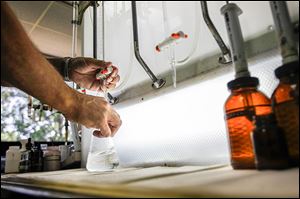
Water plants put ‘guard up’
Multiple testing done in wake of Toledo crisis
8/5/2014
Oregon water plant operator Tim Eckman pours a sample of water to test for various chemicals.
When Toledo officials sort out how and why the city’s water tested at dangerous levels for an algae-related toxin over the weekend, Kelly Frey will eagerly study their findings.
Mr. Frey, Ottawa County’s sanitary engineer, said Monday he expects Toledo’s microcystin crisis to offer guidance to other water-plant operators throughout the region about how to deal with the toxin and the algae blooming on Lake Erie that produce it.
“We want to learn as much as we can from the experience they had,” Mr. Frey said. But as of midday Monday, he said, “There hasn’t been a lot of specific information that might help.”
So in that void, Mr. Frey said, Ottawa County’s water plant is doing what it was doing before Toledo issued its no-drink order early Saturday: increasing its use of activated carbon, which along with addressing taste impurities in the water also filters out the microcystin, and stepping up tests to make sure its product is safe.
“If we can test on a daily basis, that’s what we’ll do,” Mr. Frey said.
Doug Wagner, superintendent of the water-treatment plant in Oregon, which also provides microcystin testing services for Ottawa County and several other nearby plants, said that for at least today, that will occur.
“I’m going to run [tests] again [today] just because the demand is there,” said Mr. Wagner, who had already announced plans to test water samples for microcystin at least three times per week, on Mondays, Wednesdays, and Fridays.
Although the test takes four hours to do and is rather complex, testing multiple samples simultaneously requires little additional cost or time, he said.
“If you’re going to run one set of samples, you might as well do 20,” Mr. Wagner said. On Sunday, he had said he might take samples of Oregon water daily, then test them together on his testing days.
Along with Toledo, Oregon, and Ottawa County, water utilities with intakes in Lake Erie’s Western Basin include Carroll Township, Sandusky, and Monroe, Mich.
Mr. Wagner said his tests Monday of both untreated and treated water from Oregon, Ottawa County, Carroll Township, Sandusky, and Monroe showed microcystin in all of the untreated samples, but no detectable levels in any of the treated water.
Oregon, whose intake is about a mile from Toledo’s, tested “just a fuzz over 10” parts per billion for the toxin in its raw water, which was down from 14 on Saturday and “between 15 and 20” on Friday, Mr. Wagner said.
Toxin levels at the other plants were lower, he said. Carroll Township, which had to shut its plant down for 12 days last September because of microcystin, had 8.08 parts per billion in its untreated water Monday, while Monroe tested at 1.26 parts per billion, Sandusky at 0.41 parts per billion, and Ottawa County at 0.66 parts per billion from its Lake Erie intake.
“We certainly have our guard up,” Henry Biggert, Carroll Township’s plant superintendent, said Monday. “We plan on sampling every day.”
The Carroll plant’s intake has been slowed down, Mr. Biggert said,
Ottawa County also took samples from its auxiliary intake on the Portage River, which came in higher for microcystin at 1.13 parts per billion.
The county primarily uses the river intake as a back-up during winter ice conditions that disrupt its lake intake, Mr. Frey said, but officials decided to run parallel samples during the current algae bloom to see if the river might also be a suitable alternative during that problem. One day’s test does not provide enough data to draw a conclusion, he said.
Mr. Frey said his concern is that, in the absence of more focused research on methods to address microcystin, the day will arrive when toxin levels are high enough to overwhelm the activated carbon or ozonation methods now used to treat it.
Even if efforts to control fertilizer and sewage discharges believed to provide nutrients for the algae blooms work over the long term, he said, “Next year we’re going to have the same problem, and the year after that. I’m worried that we’re going to be required to put in membrane filters, which are very expensive to install and very expensive to operate.”
Mr. Biggert said his plant uses a ozonation system installed in January. Ozone treatment oxidizes any organic matter in the water in a matter of about a minute, making it 2,000 times more effective than chlorine, he said.
Kevin Armstrong, superintendent of Monroe’s treatment plant, did not respond to a Blade inquiry Monday.
Detroit, whose water department’s sprawling service area includes parts of Monroe County, draws its water from the Detroit River and Lake Huron, with the latter source feeding 400 million gallons a day through a treatment plant at Fort Gratiot Township, Mich., near Port Huron. Lake Huron has not had algae problems comparable to Lake Erie’s.
Contact David Patch at: dpatch@theblade.com or 419-724-6094.